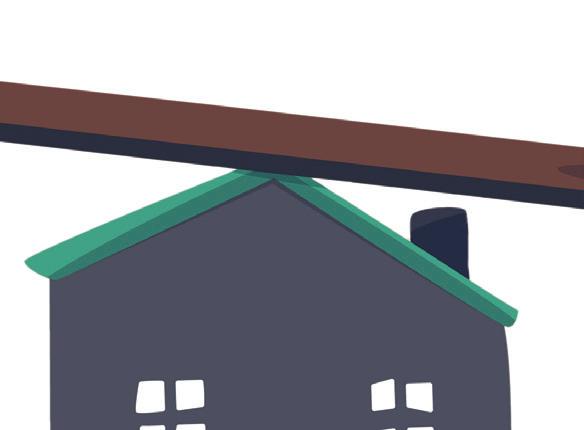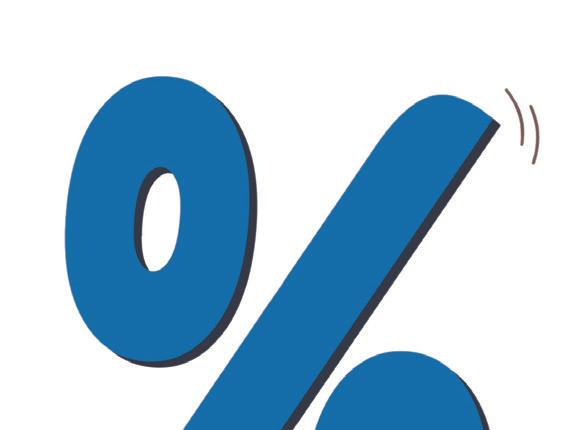
6 minute read
Ready, willing and able
In the fast-moving mortgage market, it pays to be prepared. Kay Hill looks at the latest moves in lending
There are so many variables at play in the housing market, that predictions are harder than ever! Depending on who you ask, house prices in 2023 could drop by 25% [economist Roger Bootle], drop by 8% [Halifax], drop by 2% [Rightmove] or even increase by 5-8% [David Hannah, Cornerstone Tax]. Meanwhile, mortgage interest rates could settle at around 4% [Sam Amidi, Better.co.uk] or nearer to 5% [Sarah Coles, Hargreaves Lansdown] – and that’s assuming that nothing along the lines of another Brexit, pandemic or mini-Budget comes along to cause further chaos.
Advertisement
So how does all this affect those who are getting ready to buy, and what should you be doing now?
Be Cautious But Positive
The fact that house prices are unlikely to increase sharply (if at all) in 2023 may give you breathing space to build a larger deposit, as for the first time in many years your savings are likely to be growing at a faster rate than properties. Make sure you choose the bestpaying account and save, save, save – the current financial climate could offer good opportunities for those who are ready. A larger deposit will also mean a wider selection of mortgages and lower monthly costs in the future, so it really is worth trying to put a bit more away if you can.
Be Prepared
If you are ready to buy, securing a mortgage agreement in principle you will show sellers that you are ready to move – it doesn’t commit you to taking out that particular mortgage (nor does it guarantee that you would definitely be offered a mortgage) but it marks you out as a serious buyer.
Be Realistic
The possibility of prices falling will mean that surveyors are more likely to give a valuation that is less than asking price (which could mean you
We predict an overall drop of 2% in average asking prices next year as economic headwinds continue to soften activity. However, affordability constraints will bite in some segments and sectors of the market much more than others. This will lead to a hyper-local market, where one side of a city, town or even street could fare better than another, depending on the types of property available and the desirability and affordability of the exact location. In this market, working with a good, local estate agent who knows every corner of the area will be vital. After many months of having to act extremely quickly, there will be less urgency in the market as buyers wait for the right home to become available for their needs, and some sellers will hold out hoping for a price that matches their expectations. This will lead to homes taking longer to sell, and we could see a return to the more normal time to nd a buyer of around 60 days. We’re heading towards a more even balance between supply and demand next year, but we don’t expect a surge in forced sales which would cause a glut of properties for sale and contribute to more signi cant price falls.
Tim Bannister, Director of Property Science, Rightmove

suddenly need more cash to buy the house of your dreams as the mortgage offer will be reduced following a lower valuation). In addition, lenders will be more cautious about high loan-to-value lending as the risk of a borrower falling into negative equity increases with the size of the loan.

Consider if it’s sensible not to stretch yourself to the maximum, instead allowing a little “wriggle room” by building up a larger deposit or choosing a slightly more modest home, to allow for potential hitches. If you are looking at secondhand homes, it is starting to become more of a buyer’s market, so don’t be scared to put in an initial offer at slightly below asking price.

Return Of The Variable Rate

One of the results of the catastrophic miniBudget was that the rates on fixed rate mortgages increased rapidly, as lenders reacted to the uncertainty. This caused a resurgence in interest in variable rate loans such as trackers, discounted rates and Standard Variable Rate loans.
According to Savills, before the latest crisis, 95.5% of first time buyers and 84.9% of homemovers chose a fixed rate, as these were generally cheaper and offered predictable costs. However, according to analyst Moneyfacts, by the end of October following the mini-Budget, the average rate on a tracker deal was 3.69%, compared with the average rate of 6.5% on a twoyear fixed mortgage, meaning a borrower taking out a £200,000 mortgage at the time would have saved £469 a month in interest by opting for the tracker. As some trackers and variable rates have no early repayment charges, some buyers might choose them as a stop-gap, allowing the fixed rate mortgage market time to settle – although, of course, there are both costs and stresses involved in remortgaging.
If the Bank base rate rises, trackers may once again seem less appealing than fixes, but in the meantime, it is worth considering the option if your income could cope with a sudden rise in repayments. If long term financial certainty is what you are after, then looking at fixed rates of three or five years, rather than two, should help you to ride out the current storm with less stress.
WHAT IS ON THE MARKET?
Lenders have been bringing in new products (especially trackers), with rates coming down slightly as the market has settled. In times of uncertainty, the best deals may be short lived, so a financial adviser or broker can help you find the best option. The information below, showing some of the best buys at the time of writing, was sourced from moneysavingexpert.com where you can compare the latest deals for yourself. Figures are based on the average house price of £296,000 [ONS].
With a 10% deposit: Two-year fixed rate – HSBC 5.34% Three-year fixed rate – Skipton Building Society 5.31% Five-year fixed rate – Yorkshire Building Society, 4.74% Three-year discounted tracker – The Loughborough 3.29%

With a 5% deposit Two-year fixed rate – Halifax 5.6% Three-year fixed rate – Skipton Building Society 5.81%

Five-year fixed rate with no fees and £1,000 cashback – Yorkshire Building Society 5.08%

Lifetime discount variable family mortgage – Vernon Building Society 3.9%.
Expert Comment


While it will come as a relief to many that interest rates will rise less sharply than predicted only a few weeks ago, homeowners are still facing major increases in their mortgage payments. The fact is the base rate was 0.25% at the start of the year and it’s now 3.5%, a staggering increase and set to rise even more to around 4.5% next year according to the markets. And while house prices seem to have peaked and are likely to drop further in the new year, higher interest rates on mortgages will mean buying a home is still unaffordable for many. Shopping around for a good mortgage deal will be essential, as will keeping spending in check, avoiding all large expenses if possible and minimising additional borrowing while looking for a mortgage. People seeking a mortgage should bear in mind that the average interest rate on a two-year x can be higher than veyear and 10-year xes. Mortgage approvals decreased again in October compared to September, suggesting securing a mortgage is becoming more dif cult. To shore up nances for what lies ahead, we’d strongly encourage everyone to review their nances with nancial resilience in mind.
In his brief stint as Chancellor, Kwasi Kwarteng raised the threshold for Stamp Duty payments from £125,000 to £250,000, which he announced would be a permanent change – but his budget of heavy tax cuts led to his sacking as Chancellor.
Having taken over, in his Autumn Statement last November, Jeremy Hunt announced that these cuts would not be permanent and will only stay in place until 31 March 2025. Making the announcement, Hunt said that the Office for Budget Responsibility, OBR, expected housing activity to slow over the next two years: “After that, I will sunset the measure, creating an incentive to support the housing market and all the jobs associated with it by boosting transactions during the period the economy most needs it.”
HOW MUCH IS STAMP DUTY?
The SDLT rises according to the property’s purchase price. Rates paid are different depending on whether you are buying in England, or in Wales or Scotland where the tax has a different name.
In England and Northern Ireland current rates are:
9 Up to £250,000 (£425,000 for first time buyers) = 0%:
9 The portion from £250,001 to £925,000 = 5%
9 The portion from £925,001 to £1,500,000 = 10%
9 The portion above £1,500,000 = 12%:
Previously, the discounted 0% rate for first time buyers only applied to homes up to £500,000 (over that, the standard rates applied). The Chancellor extended this to properties costing up to £625,000. For






